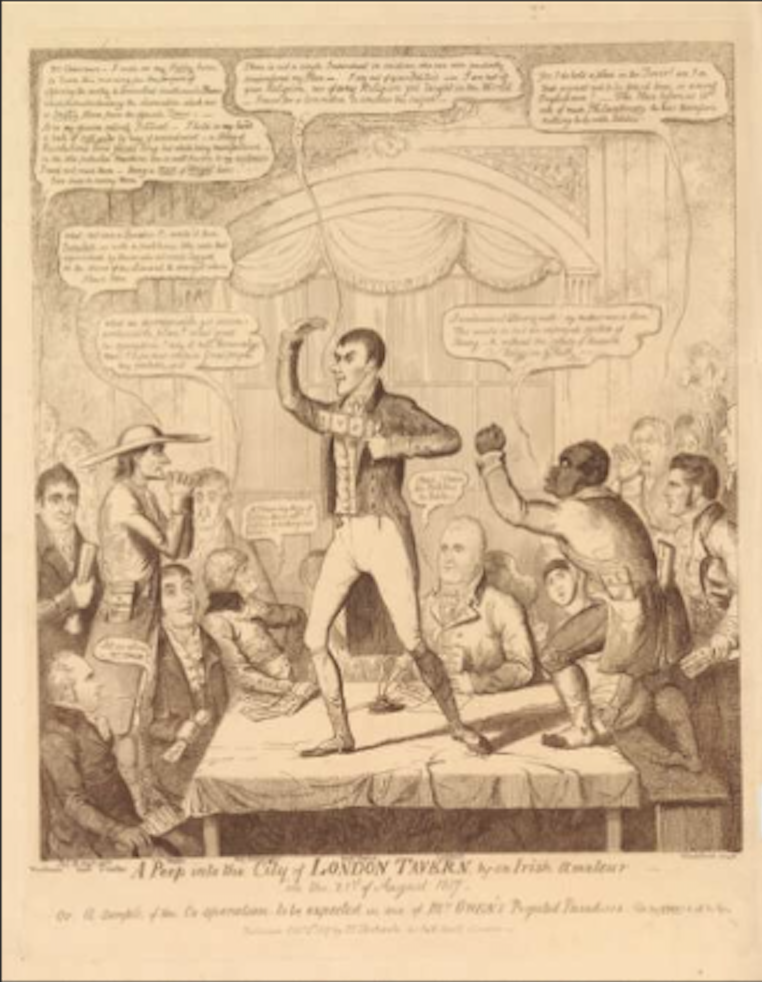Robert Wedderburn
1762-1835
Robert Wedderburn was born in Kingston, Jamaica in 1762. He was one of the illegitimate children of James Wedderburn Colvile, a Scottish surgeon and slave trader, and Rosanna, an African-born enslaved person. Robert’s father sold Rosanna to Lady Douglas when she was five months pregnant with Robert, who was emancipated by his father in 1765. James Wedderburn had eight plantations in Westmoreland: Mint, Paradise, Retreat, Endeavor, Inverness, Spring Garden, Moreland, and Mount Edgcombe. Together they were worth over £300,000 which he left to his three legitimate children and wife at the time of his death.
Robert left Lady Douglas’s plantation, travelled around Jamaica for a few years and joined the Royal Navy. He then travelled to England aboard the HMS Nabob in 1778 at the age of 17 and lived in the district of Giles-in-the-Fields, London. He married Elizabeth Ryan on November 5, 1781, before returning to the Royal Navy to serve aboard the HMS Polyphemus.
He became a Methodist in the late 1780s. He was a radical preacher whose printed sermons circulated in London. He is prominently known for Truth Self-Supported (1802), Axe Laid to the Root (1817), and The Horrors of Slavery (1824). In a letter to Bell’s Life in London Robert invoke a scandal over his kinship to his father, James Wedderburn. His father and his half-brother, Andrew Colvile, consequently disowning him. His half-sister, Lady Selkirk or Jean Wedderburn Selkirk who married Thomas Selkirk one of the owners of Hudson Bay’s Company.
Wedderburn’s involvement with the Unitarian movement, which allowed individuals to develop their own religious opinions, led him to meet Thomas Spence in 1812, the unofficial leader of radical reformers who advocated revolution. Wedderburn was a tailor before being licensed as a Unitarian clergyman in 1813. Spence’s death in 1814 pushed Wedderburn to become a prominent reformer. Together with Thomas Preston, John Hopper, Thomas Evans, Allen Davenport, Arthur Thistlewood, James Ings, John Brunt, William Davidson and Richard Tidd, he was associated with the “Spencean Philanthropists.” Robert Wedderburn edited a London periodical, Axe Laid to the Root, which encouraged a simultaneous rebellion of English wage slaves and West Indian chattel slaves.
He became progressively more engaged in radical politics and was vigorous in his attacks on the institution of slavery. He was charged with anti-Christian Spencean speeches and imprisoned in Dorchester jail for two years in 1820. While in prison, he wrote “An Address to Lord Brougham and Vaux,” an anti-abolitionist region, suggesting that slaves should be able to purchase their freedom individually, and attacked the methods of earlier abolitionist campaigns.
Wedderburn defended the inherent rights of Caribbean slaves to murder their masters. He allegedly told around 200 people that the English government sent armed men to Africa and the West Indies to steal blacks, especially women. After this occasion, he was tried and released on a charge of blasphemy.
Wedderburn was arrested and imprisoned in Giltspur Street Prison in 1831 at the age of 68. His last known letter was written to Francis Place while in prison. The exact time of his death is unknown although the official register of death is 1837.
Prepared by Golgisoo Jafari, 25 July 2021
RELATED FILES AND IMAGES
REFERENCES
Coleman, Deirdre. "Conspicuous Consumption: White Abolitionism and English Women's Protest Writing in the 1790s." English Literary History 61: 2 (1994), 341-62.
Davis, David Brion. "Reflections on Abolitionism and Ideological Hegemony." The American Historical Review 92:4 (1987), 797-812.
Edwards, Paul. "Pioneering Amongst the Black British Georgians." Black American Literature Forum 23:4 (1989), 792-98.
Gilroy, Paul. 1993. The Black Atlantic: Modernity and Double Consciousness. London: Verso.
Wedderburn, Robert, The Horrors of Slavery, London: 1824
This webpage was last updated on 2021-10-08 by Kartikay Chadha
